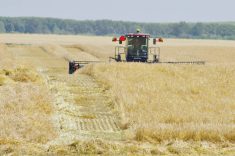Warm, dry late-harvest weather partially salvaged Western Canada’s small, low-quality crops of wheat and barley, raising harvest and export prospects, a top Canadian Wheat Board official said Oct. 29.
The board expects to export up to 15.8 million tonnes of wheat and barley in the current 2010-11 crop year, up about five per cent from its July estimate, thanks to larger crops than it expected earlier.
Exports still look to be the smallest in six years and sharply lower than last year’s 18.8 million tonnes, which was the highest volume in a decade.
Read Also

Manitoba sclerotinia picture mixed for 2025
Variations in weather and crop development in this year’s Manitoba canola fields make blanket sclerotinia outlooks hard to pin down
Favourable weather arrived late, but still in time to help finish crops that struggled with too much rain in spring and late summer.
“October was important in getting the crop off, period,” chief operating officer Ward Weisensel said in an interview with Reuters. “We would have preferred to have that (weather) earlier because we would have had better quality, no question.”
Canada, the No. 6 wheat grower, is just one of several key wheat-producing countries that saw bad weather curtail crop output and quality this year.
The board said the 2010’s world wheat crops lack quality, with prospects for Southern Hemisphere wheat unlikely to improve supplies of top grades.
Overall, the world wheat supply remains adequate, the board said, despite poor production in drought-plagued Russia and Ukraine, which have imposed export restrictions.
“I don’t think we’re seeing buyers changing their buying behaviour in terms of timing, but we are seeing them have to shift from areas that do not have the quantities to areas that do,” Weisensel said. The United States and Europe will likely pick up the slack in the wheat trade.
The CWB pegs Western Canada’s all-wheat crop at 20 million tonnes, up from its midsummer estimate of 18.45 million tonnes.
The durum crop looks to total 3.3 million tonnes, up from the July estimate of 2.9 million tonnes, while the barley harvest is coming in at 8.1 million tonnes, over the board’s last estimate of 7.4 million tonnes.
The crop’s quality is the worst in six years. A little more than one-third of Western Canada’s spring wheat and about one-quarter of durum will likely make the top two grades prized by millers and pasta producers, compared to more than three-quarters last year, Weisensel said.
“That is a very significant shift,” he said.
Protein content should be similar to last year around 13.3 per cent, a little lower than average.


















